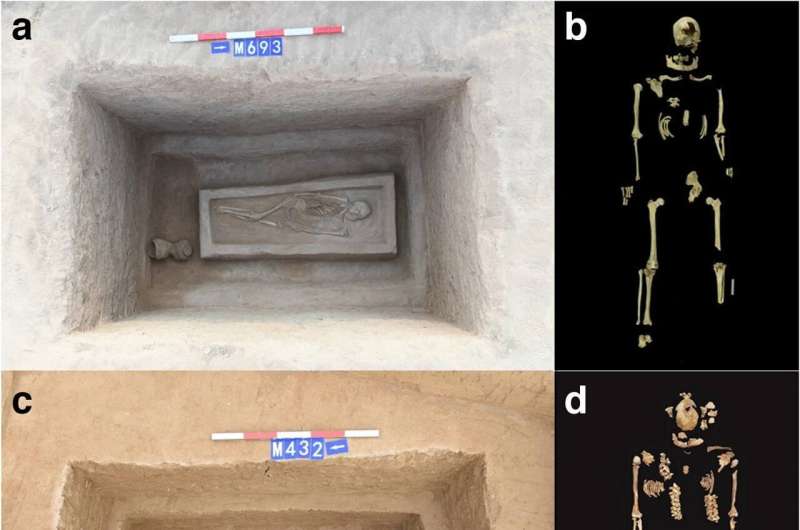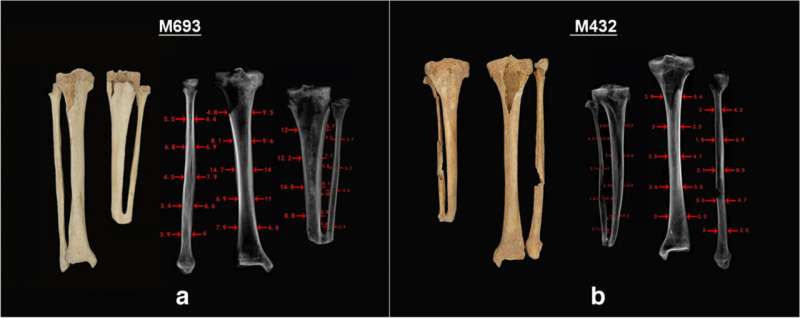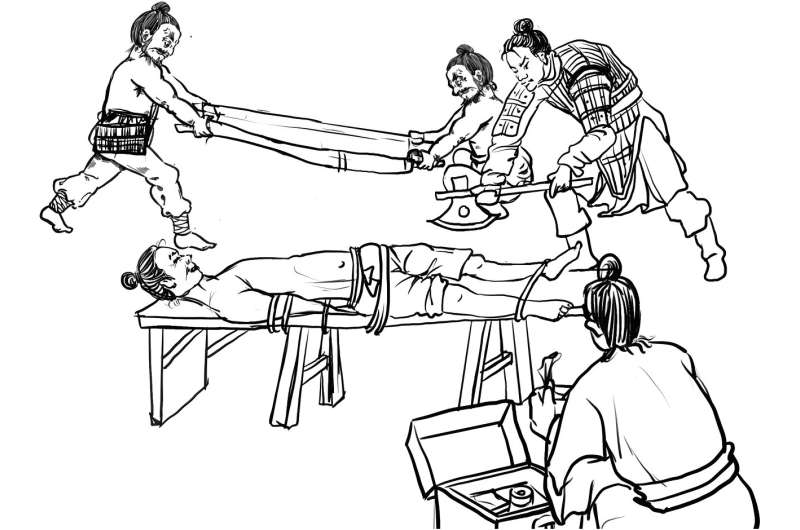This article has been reviewed according to Science X's editorial process and policies. Editors have highlighted the following attributes while ensuring the content's credibility:
fact-checked
trusted source
proofread
Remains of two men from central China shed light on ancient practice of punitive amputation

It's a scene straight out of a mystery novel: The skeletons of two unrelated men show signs of remarkably similar injuries. One is missing about one-fifth of his lower left leg, while the other is missing the same length of bone, down to the centimeter, on his right.
Add the fact that both victims have been dead for more than 2,000 years, and this puzzle has the potential to stump even the most seasoned crime scene investigator.
Enter Dr. Qian Wang, a paleoanthropologist and professor at Texas A&M University's School of Dentistry whose research sheds light on the distinct cultures and burial practices of ancient China. His examination of the two men's remains has revealed crucial details about who these individuals were, and how they might have incurred such similar losses to their lower limbs.
According to Wang's study, published this spring in collaboration with three researchers from China's Henan Province, where the remains were discovered, both men were members of the aristocracy during the Eastern Zhou Dynasty, and both were likely subjected to an ancient form of criminal punishment known as Yue. This practice sought to permanently shame and impair criminals by removing parts of the body.
The study is published in the journal Archaeological and Anthropological Sciences.
"Based on penal laws of the Zhou Dynasty, Yue, or punitive amputation, was executed in criminal cases including deceiving the monarch, fleeing from duties, stealing, and so on," Wang explained, noting that this form of punishment was one step below execution in the Zhou penal system. "On some occasions, it could (serve as) a reduced penalty in lieu of death to reflect leniency."
In this case, both men had one of their feet and about 8 centimeters or one-fifth of a leg removed, which Wang said is consistent with the Zhou Dynasty's punitive amputation practices, mirroring the remains of other individuals thought to have been similarly punished during this period.
While amputations were also used in a medical context to treat trauma and disease, Wang said these two amputations make more sense within this punitive framework. "Based on historical and archaeological context, penal amputation is most plausible," he said.
The skeletons of the two men, both of whom died at different times between 2,300 and 2,500 years ago, were unearthed at an archaeological site in the northwestern portion of Sanmenxia City, situated along the Yellow River about 500 miles southwest of Beijing.
Though it's impossible to know what exactly they were accused of, Wang said their crimes may have differed in severity, as historical evidence suggests that amputation of the right leg was reserved for more serious offenses.
"Punitive amputation of both feet was reserved for even higher serious felonies," he said.

In both cases, the leg that received the amputation showed significant signs of healing, with the remaining sections of bone cleanly fused together at the bottom. Wang said bone typically takes several months to heal, after which the men continued to live for an indeterminate number of years.
Over time, however, unused bones begin to deteriorate and become brittle; Wang observed more of this "disuse atrophy" in the individual with the right leg amputation, suggesting that he may have lived longer with his amputation than the other man.
"Since amputation by penalty was not an uncommon phenomenon, they might (have) returned to normal social life and were buried in a proper manner after death," Wang said, noting that the men's high status likely eased their physical and social recovery.
"These cases enrich our understanding of the penal laws and their implementations, medical care capabilities, and the general benevolent attitudes towards those who were punished by law from the social and archaeological contexts of ancient China."
Layers of evidence
As part of their investigation, Wang and his fellow researchers used existing knowledge of Zhou-era burial practices to pinpoint the position of the two men within the social and political hierarchy.
"The Zhou Dynasty had a distinct hierarchical system, called The Way of Rituals, which defined the different social statuses of people during life and after death," Wang said. "(This system) was mapped into burial patterns, whereby social status (was) indicated by tomb sizes, tomb orientations, layers of coffin and grave goods."
The existence of multi-layered coffins for higher-ranking individuals is particularly useful, Wang explained, as the number of layers can be analyzed to narrow down their position within this hierarchy: Seven coffin layers were used for a king, five for regional rulers, three for high-level government officials, and two for low-level officials.
"In this research, two individuals were buried in two-layered coffins in north-south direction," Wang said, noting that this north-south orientation was typically reserved for members of the upper class, with commoners relegated to smaller, east-west oriented tombs.
The presence of goods such as pots and stone tablets at the graves further strengthens the case for the men being social elites, while an analysis of specific isotopes in the subjects' bone tissue implied that they were both well-nourished—yet another clue pointing to their elevated status.
"Isotopic analysis suggests a protein-rich diet in conformity with the Eastern Zhou aristocratic class," Wang said. "[Based on all of these factors], they were most possibly low-level officials."

A common practice
In many ancient societies, reduction or removal of body parts was a typical punishment for crimes such as theft, vagrancy and false witness, Wang said. In addition to leg amputations, other forms of bodily punishment in Zhou Dynasty China involved removing the convicted person's nose or genitals.
"Punitive amputation was officially stopped in the Han Dynasty during the reign of Wendi in 167 BCE, with a decree to stop 'punishment by body reduction,'" Wang said. "It was replaced with more humane measures such as flogging, hard labor and/or imprisonment.
"However," he said, "the practice was not totally eradicated. Evidence of punitive amputations, most commonly of the foot, were still found in subsequent dynasties; the latest case was from the Qing Dynasty (1644–1911 CE), in which both feet of a male individual were amputated by sawing."
Some famous victims of punitive amputations during the Zhou Dynasty include the military strategist and writer Sun Bin, as well as Bian He, whose unfortunate tale has become an iconic piece of Chinese history and lore.
"Bian He learned the consequences of deceiving the kings of Chu State," Wang said. "They cut off his left foot, then his right after they determined twice that a valuable jade that Bian He had found was worthless. Only later was it discovered that the jade was authentic."
Punitive amputation of feet and legs was so common, Wang said, that the legendary philosopher Han Feizi made special note of it in his writings. This spawned a famous Chinese idiom stating that because of this cruel and commonplace punishment, shoes became cheaper and prosthetics more expensive.
As Wang notes in the study, the routine nature of punitive amputation would have required significant collaboration between the penal system and medical professionals, with established protocols for removing the leg, closing the wound and caring for the patient afterward. Those of a higher social caste might even have had access to pain-relieving agents during and after the procedure, he said.
In the case of the two men discovered in Sanmenxia City, Wang said the lack of secondary fractures and bone fragments may be indicative of improvements in amputation practices and nursing care during the Eastern Zhou Dynasty, compared to those of the earlier Western Zhou and Shang dynasties.
"The sign of punishment by amputation and signs of good post-punishment recovery reflects a well-established amputation protocol including post-execution nursing and patient management to facilitate survival and recovery," Wang said. "In these two cases, two amputees survived well because of this refined penal and medical coordination."
More information: Yawei Zhou et al, Surviving punishment by body reduction in a hierarchical society: A bioarcheological study of two punitive amputation cases in Eastern Zhou Dynasty (771–256 BCE) with references to the penal and medical systems of ancient China, Archaeological and Anthropological Sciences (2024). DOI: 10.1007/s12520-024-01961-2
Provided by Texas A&M University




















